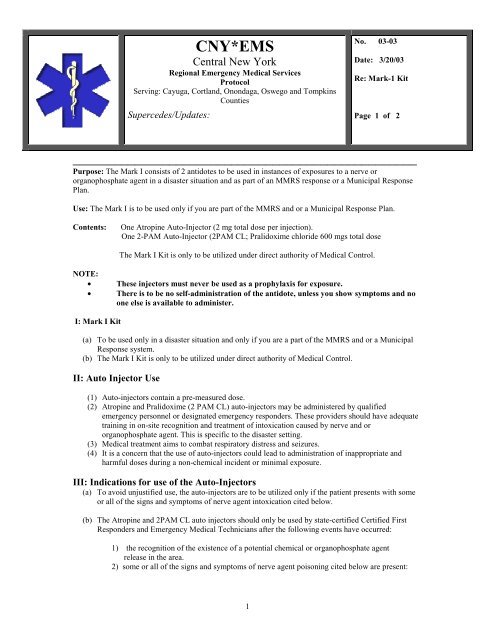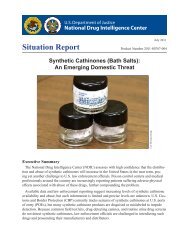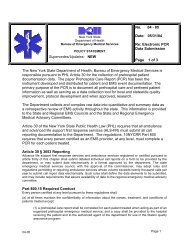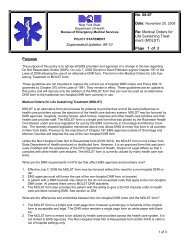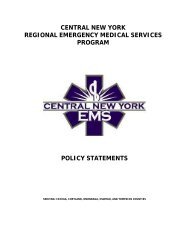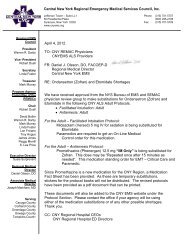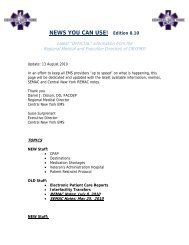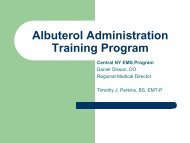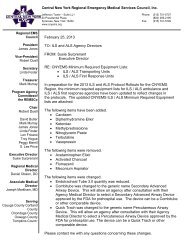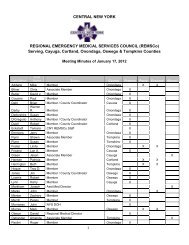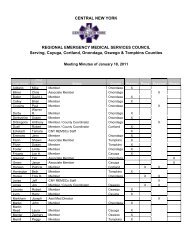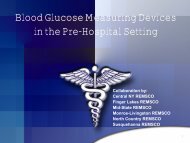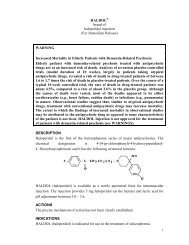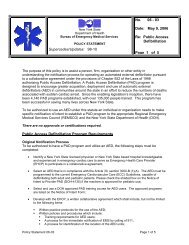II: Auto Injector Use - CNY EMS
II: Auto Injector Use - CNY EMS
II: Auto Injector Use - CNY EMS
Create successful ePaper yourself
Turn your PDF publications into a flip-book with our unique Google optimized e-Paper software.
<strong>CNY</strong>*<strong>EMS</strong><br />
Central New York<br />
Regional Emergency Medical Services<br />
Protocol<br />
Serving: Cayuga, Cortland, Onondaga, Oswego and Tompkins<br />
Counties<br />
Supercedes/Updates:<br />
No. 03-03<br />
Date: 3/20/03<br />
Re: Mark-1 Kit<br />
Page 1 of 2<br />
__________________________________________________<br />
Purpose: The Mark I consists of 2 antidotes to be used in instances of exposures to a nerve or<br />
organophosphate agent in a disaster situation and as part of an MMRS response or a Municipal Response<br />
Plan.<br />
<strong>Use</strong>: The Mark I is to be used only if you are part of the MMRS and or a Municipal Response Plan.<br />
Contents:<br />
One Atropine <strong>Auto</strong>-<strong>Injector</strong> (2 mg total dose per injection).<br />
One 2-PAM <strong>Auto</strong>-<strong>Injector</strong> (2PAM CL; Pralidoxime chloride 600 mgs total dose<br />
The Mark I Kit is only to be utilized under direct authority of Medical Control.<br />
NOTE:<br />
• These injectors must never be used as a prophylaxis for exposure.<br />
• There is to be no self-administration of the antidote, unless you show symptoms and no<br />
one else is available to administer.<br />
I: Mark I Kit<br />
(a) To be used only in a disaster situation and only if you are a part of the MMRS and or a Municipal<br />
Response system.<br />
(b) The Mark I Kit is only to be utilized under direct authority of Medical Control.<br />
<strong>II</strong>: <strong>Auto</strong> <strong>Injector</strong> <strong>Use</strong><br />
(1) <strong>Auto</strong>-injectors contain a pre-measured dose.<br />
(2) Atropine and Pralidoxime (2 PAM CL) auto-injectors may be administered by qualified<br />
emergency personnel or designated emergency responders. These providers should have adequate<br />
training in on-site recognition and treatment of intoxication caused by nerve and or<br />
organophosphate agent. This is specific to the disaster setting.<br />
(3) Medical treatment aims to combat respiratory distress and seizures.<br />
(4) It is a concern that the use of auto-injectors could lead to administration of inappropriate and<br />
harmful doses during a non-chemical incident or minimal exposure.<br />
<strong>II</strong>I: Indications for use of the <strong>Auto</strong>-<strong>Injector</strong>s<br />
(a) To avoid unjustified use, the auto-injectors are to be utilized only if the patient presents with some<br />
or all of the signs and symptoms of nerve agent intoxication cited below.<br />
(b) The Atropine and 2PAM CL auto injectors should only be used by state-certified Certified First<br />
Responders and Emergency Medical Technicians after the following events have occurred:<br />
1) the recognition of the existence of a potential chemical or organophosphate agent<br />
release in the area.<br />
2) some or all of the signs and symptoms of nerve agent poisoning cited below are present:<br />
1
SLUDGEM + RESPIRATIONS and AGITATION<br />
S-salivation (excessive drooling)<br />
L- lacrimation (tearing)<br />
U- urination<br />
D- defecation (diarrhea)<br />
G- GI upset (cramps)<br />
E- emesis (vomiting)<br />
M- muscle (twitching, spasm,”bag of worms”)<br />
+<br />
RESPIRATIONS – difficulty breathing / distress (sob, wheezing)<br />
+<br />
AGITATION + CNS SIGNS – confusion, agitation, seizures, coma<br />
Atropine must be given first: do not give anything else until the effects of atropine begin to appear<br />
(decreased secretion and increased heart rate). Only after the effects of atropine are seen can you then<br />
give 2-PAM CL.<br />
If signs and symptoms resolve, then only monitoring is necessary.<br />
If severe signs and symptoms are present; three (3) Atropine auto-injectors and<br />
three (3) 2-PAM CL auto-injectors should be administered in rapid succession<br />
(stacked).<br />
IV: Treatments should include<br />
(1) Removal of secretions<br />
(2) Maintain an open airway<br />
(3) <strong>Use</strong> artificial ventilations if necessary and possible<br />
(4) Repeat atropine immediately as needed<br />
(5) Pralidoxime (2-Pam CL) is most effective if administered as soon as possible after the<br />
poisoning but not before atropine, especially for severe exposures<br />
(6) If available Diazepam (Valium) may be cautiously given, if convulsions are not controlled<br />
(7) When the nerve agent has been ingested, exposure may continue for some time due to slow<br />
absorption from the bowel, and fatal relapses have been reported after initial improvement.<br />
Continued medical monitoring and transport is mandatory<br />
(8) If dermal exposure has occurred, decontamination is critical and should be done with the<br />
standard decontamination procedures. Patient monitoring should be directed to the same signs<br />
and symptoms as with all nerve agent or organophosphate exposures.<br />
(9) Recommended pediatric auto-injector doses.<br />


